Kitchen
A kitchen is a room or part of a room used for cooking and food preparation in a dwelling or in a commercial establishment. A modern middle-class residential kitchen is typically equipped with a stove, a sink with hot and cold running water, a refrigerator, and worktops and kitchen cabinets arranged according to a modular design. Many households have a microwave oven, a dishwasher, and other electric appliances. The main functions of a kitchen are to store, prepare and cook food (and to complete related tasks such as dishwashing). The room or area may also be used for dining (or small meals such as breakfast), entertaining and laundry. The design and construction of kitchens is a huge market all over the world.
Commercial kitchens are found in restaurants, cafeterias, hotels, hospitals, educational and workplace facilities, army barracks, and similar establishments. These kitchens are generally larger and equipped with bigger and more heavy-duty equipment than a residential kitchen. For example, a large restaurant may have a huge walk-in refrigerator and a large commercial dishwasher machine. In some instances commercial kitchen equipment such as commercial sinks are used in household settings as it offers ease of use for food preparation and high durability.[1][2]
In developed countries, commercial kitchens are generally subject to public health laws. They are inspected periodically by public-health officials, and forced to close if they do not meet hygienic requirements mandated by law.
History
The evolution of the kitchen is linked to the invention of the cooking range or stove and the development of water infrastructure capable of supplying running water to private homes. Food was cooked over an open fire. Technical advances in heating food in the 18th and 19th centuries changed the architecture of the kitchen. Before the advent of modern pipes, water was brought from an outdoor source such as wells, pumps or springs.
Antiquity
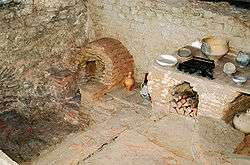
The houses in Ancient Greece were commonly of the atrium-type: the rooms were arranged around a central courtyard for women. In many such homes, a covered but otherwise open patio served as the kitchen. Homes of the wealthy had the kitchen as a separate room, usually next to a bathroom (so that both rooms could be heated by the kitchen fire), both rooms being accessible from the court. In such houses, there was often a separate small storage room in the back of the kitchen used for storing food and kitchen utensils.
In the Roman Empire, common folk in cities often had no kitchen of their own; they did their cooking in large public kitchens. Some had small mobile bronze stoves, on which a fire could be lit for cooking. Wealthy Romans had relatively well-equipped kitchens. In a Roman villa, the kitchen was typically integrated into the main building as a separate room, set apart for practical reasons of smoke and sociological reasons of the kitchen being operated by slaves. The fireplace was typically on the floor, placed at a wall—sometimes raised a little bit—such that one had to kneel to cook. There were no chimneys.
Middle Ages

Early medieval European longhouses had an open fire under the highest point of the building. The "kitchen area" was between the entrance and the fireplace. In wealthy homes there was typically more than one kitchen. In some homes there were upwards of three kitchens. The kitchens were divided based on the types of food prepared in them.[3] In place of a chimney, these early buildings had a hole in the roof through which some of the smoke could escape. Besides cooking, the fire also served as a source of heat and light to the single-room building. A similar design can be found in the Iroquois longhouses of North America.
In the larger homesteads of European nobles, the kitchen was sometimes in a separate sunken floor building to keep the main building, which served social and official purposes, free from indoor smoke.
The first known stoves in Japan date from about the same time. The earliest findings are from the Kofun period (3rd to 6th century). These stoves, called kamado, were typically made of clay and mortar; they were fired with wood or charcoal through a hole in the front and had a hole in the top, into which a pot could be hanged by its rim. This type of stove remained in use for centuries to come, with only minor modifications. Like in Europe, the wealthier homes had a separate building which served for cooking. A kind of open fire pit fired with charcoal, called irori, remained in use as the secondary stove in most homes until the Edo period (17th to 19th century). A kamado was used to cook the staple food, for instance rice, while irori served both to cook side dishes and as a heat source.
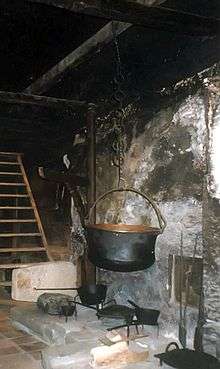
The kitchen remained largely unaffected by architectural advances throughout the Middle Ages; open fire remained the only method of heating food. European medieval kitchens were dark, smoky, and sooty places, whence their name "smoke kitchen". In European medieval cities around the 10th to 12th centuries, the kitchen still used an open fire hearth in the middle of the room. In wealthy homes, the ground floor was often used as a stable while the kitchen was located on the floor above, like the bedroom and the hall. In castles and monasteries, the living and working areas were separated; the kitchen was sometimes moved to a separate building, and thus could not serve anymore to heat the living rooms. In some castles the kitchen was retained in the same structure, but servants were strictly separated from nobles, by constructing separate spiral stone staircases for use of servants to bring food to upper levels. The kitchen might be separate from the great hall due to the smoke from cooking fires and the chance the fires may get out of control.[4] Few medieval kitchens survive as they were "notoriously ephemeral structures".[5] An extant example of such a medieval kitchen with servants' staircase is at Muchalls Castle in Scotland. In Japanese homes, the kitchen started to become a separate room within the main building at that time.
With the advent of the chimney, the hearth moved from the center of the room to one wall, and the first brick-and-mortar hearths were built. The fire was lit on top of the construction; a vault underneath served to store wood. Pots made of iron, bronze, or copper started to replace the pottery used earlier. The temperature was controlled by hanging the pot higher or lower over the fire, or placing it on a trivet or directly on the hot ashes. Using open fire for cooking (and heating) was risky; fires devastating whole cities occurred frequently.
Leonardo da Vinci invented an automated system for a rotating spit for spit-roasting: a propeller in the chimney made the spit turn all by itself. This kind of system was widely used in wealthier homes. Beginning in the late Middle Ages, kitchens in Europe lost their home-heating function even more and were increasingly moved from the living area into a separate room. The living room was now heated by cocklestoves, operated from the kitchen, which offered the huge advantage of not filling the room with smoke.
Freed from smoke and dirt, the living room thus began to serve as an area for social functions and increasingly became a showcase for the owner's wealth. In the upper classes, cooking and the kitchen were the domain of the servants, and the kitchen was set apart from the living rooms, sometimes even far from the dining room. Poorer homes often did not yet have a separate kitchen; they kept the one-room arrangement where all activities took place, or at the most had the kitchen in the entrance hall.

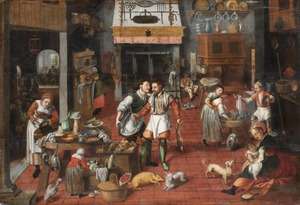
The medieval smoke kitchen (or Farmhouse kitchen) remained common, especially in rural farmhouses and generally in poorer homes, until much later. In a few European farmhouses, the smoke kitchen was in regular use until the middle of the 20th century. These houses often had no chimney, but only a smoke hood above the fireplace, made of wood and covered with clay, used to smoke meat. The smoke rose more or less freely, warming the upstairs rooms and protecting the woodwork from vermin.
Colonial America
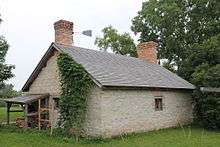
In Connecticut, as in other colonies of New England during Colonial America, kitchens were often built as separate rooms and were located behind the parlor and keeping room or dining room. One early record of a kitchen is found in the 1648 inventory of the estate of a John Porter of Windsor, Connecticut. The inventory lists goods in the house "over the kittchin" and "in the kittchin". The items listed in the kitchen were: silver spoons, pewter, brass, iron, arms, ammunition, hemp, flax and "other implements about the room".[6] Separate summer kitchens were also common on large farms in the north; these were used to prepare meals for harvest workers and tasks such as canning during the warm summer months, to keep the heat out of the main house.
In the southern states, where the climate and sociological conditions differed from the north, the kitchen was often relegated to an outbuilding. On plantations, it was separate from the big house or mansion in much the same way as the feudal kitchen in medieval Europe: the kitchen was operated by slaves in the antebellum years. Their working place was separated from the living area of the masters by the social standards, but more importantly, it was a means to reduce the chance of fire in the main house from kitchen operations.
Technological advances
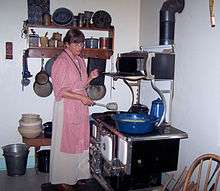
Technological advances during industrialisation brought major changes to the kitchen. Iron stoves, which enclosed the fire completely and were more efficient, appeared. Early models included the Franklin stove around 1740, which was a furnace stove intended for heating, not for cooking. Benjamin Thompson in England designed his "Rumford stove" around 1800. This stove was much more energy efficient than earlier stoves; it used one fire to heat several pots, which were hung into holes on top of the stove and were thus heated from all sides instead of just from the bottom. However, his stove was designed for large kitchens; it was too big for domestic use. The "Oberlin stove" was a refinement of the technique that resulted in a size reduction; it was patented in the U.S. in 1834 and became a commercial success with some 90,000 units sold over the next 30 years. These stoves were still fired with wood or coal. Although the first gas street lamps were installed in Paris, London, and Berlin at the beginning of the 1820s and the first U.S. patent on a gas stove was granted in 1825, it was not until the late 19th century that using gas for lighting and cooking became commonplace in urban areas. Before and after the beginning of the 20th century, kitchens were frequently not equipped with built-in cabinetry, and the lack of storage space in the kitchen became a real problem. The Hoosier Manufacturing Co. of Indiana adapted an existing furniture piece, the baker's cabinet, which had a similar structure of a table top with some cabinets above it (and frequently flour bins beneath) to solve the storage problem. By rearranging the parts and taking advantage of (then) modern metal working, they were able to produce a well-organized, compact cabinet which answered the home cook's needs for storage and working space. A distinctive feature of the Hoosier cabinet is its accessories. As originally supplied, they were equipped with various racks and other hardware to hold and organize spices and various staples. One useful feature was the combination flour-bin/sifter, a tin hopper that could be used without having to remove it from the cabinet. A similar sugar bin was also common.
The urbanization in the second half of the 19th century induced other significant changes that would ultimately change the kitchen. Out of sheer necessity, cities began planning and building water distribution pipes into homes, and built sewers to deal with the waste water. Gas pipes were laid; gas was used first for lighting purposes, but once the network had grown sufficiently, it also became available for heating and cooking on gas stoves. At the turn of the 20th century, electricity had been mastered well enough to become a commercially viable alternative to gas and slowly started replacing the latter. But like the gas stove, the electric stove had a slow start. The first electrical stove had been presented in 1893 at the World's Columbian Exposition in Chicago, but it was not until the 1930s that the technology was stable enough and began to take off.

Industrialization
Industrialization also caused social changes. The new factory working class in the cities was housed under generally poor conditions. Whole families lived in small one or two-room apartments in tenement buildings up to six stories high, badly aired and with insufficient lighting. Sometimes, they shared apartments with "night sleepers", unmarried men who paid for a bed at night. The kitchen in such an apartment was often used as a living and sleeping room, and even as a bathroom. Water had to be fetched from wells and heated on the stove. Water pipes were laid only towards the end of the 19th century, and then often only with one tap per building or per story. Brick-and-mortar stoves fired with coal remained the norm until well into the second half of the century. Pots and kitchenware were typically stored on open shelves, and parts of the room could be separated from the rest using simple curtains.
In contrast, there were no dramatic changes for the upper classes. The kitchen, located in the basement or the ground floor, continued to be operated by servants. In some houses, water pumps were installed, and some even had kitchen sinks and drains (but no water on tap yet, except for some feudal kitchens in castles). The kitchen became a much cleaner space with the advent of "cooking machines", closed stoves made of iron plates and fired by wood and increasingly charcoal or coal, and that had flue pipes connected to the chimney. For the servants the kitchen continued to also serve as a sleeping room; they slept either on the floor, or later in narrow spaces above a lowered ceiling, for the new stoves with their smoke outlet no longer required a high ceiling in the kitchen. The kitchen floors were tiled; kitchenware was neatly stored in cupboards to protect them from dust and steam. A large table served as a workbench; there were at least as many chairs as there were servants, for the table in the kitchen also doubled as the eating place for the servants.
World War II cooking and dining trends
The urban middle class imitated the luxurious dining styles of the upper class as best as they could. Living in smaller apartments, the kitchen was the main room—here, the family lived. The study or living room was saved for special occasions such as an occasional dinner invitation. Because of this, these middle-class kitchens were often more homely than those of the upper class, where the kitchen was a work-only room occupied only by the servants. Besides a cupboard to store the kitchenware, there were a table and chairs, where the family would dine, and sometimes—if space allowed—even a fauteuil or a couch.
.%22%2C_ca._1941_-_ca._1945_-_NARA_-_535820.jpg)
Gas pipes were first laid in the late 19th century, and gas stoves started to replace the older coal-fired stoves. Gas was more expensive than coal, though, and thus the new technology was first installed in the wealthier homes. Where workers' apartments were equipped with a gas stove, gas distribution would go through a coin meter.
In rural areas, the older technology using coal or wood stoves or even brick-and-mortar open fireplaces remained common throughout. Gas and water pipes were first installed in the big cities; small villages were connected only much later.
Rationalization
The trend to increasing gasification and electrification continued at the turn of the 20th century. In industry, it was the phase of work process optimization. Taylorism was born, and time-motion studies were used to optimize processes. These ideas also spilled over into domestic kitchen architecture because of a growing trend that called for a professionalization of household work, started in the mid-19th century by Catharine Beecher and amplified by Christine Frederick's publications in the 1910s.
A stepstone was the kitchen designed in Frankfurt by Margarethe Schütte-Lihotzky. Working-class women frequently worked in factories to ensure the family's survival, as the men's wages often did not suffice. Social housing projects led to the next milestone: the Frankfurt Kitchen. Developed in 1926, this kitchen measured 1.9 m by 3.4 m (approximately 6 ft 2 in by 11 ft 2 in, with a standard layout). It was built for two purposes: to optimize kitchen work to reduce cooking time and lower the cost of building decently equipped kitchens. The design, created by Margarete Schütte-Lihotzky, was the result of detailed time-motion studies and interviews with future tenants to identify what they needed from their kitchens. Schütte-Lihotzky's fitted kitchen was built in some 10,000 apartments in the housing projects erected in Frankfurt in the 1930s.[7]
The initial reception was critical: it was so small that only one person could work in it; some storage spaces intended for raw loose food ingredients such as flour were reachable by children. But the Frankfurt kitchen embodied a standard for the rest of the 20th century in rental apartments: the "work kitchen". It was criticized as "exiling the women in the kitchen", but post-World War II economic reasons prevailed. The kitchen once more was seen as a work place that needed to be separated from the living areas. Practical reasons also played a role in this development: just as in the bourgeois homes of the past, one reason for separating the kitchen was to keep the steam and smells of cooking out of the living room.
Unit/fitted

The idea of standardized was first introduced locally with the Frankfurt kitchen, but later defined new in the "Swedish kitchen" (Svensk köksstandard, Swedish kitchen standard). The equipment used remained a standard for years to come: hot and cold water on tap and a kitchen sink and an electrical or gas stove and oven. Not much later, the refrigerator was added as a standard item. The concept was refined in the "Swedish kitchen" using unit furniture with wooden fronts for the kitchen cabinets. Soon, the concept was amended by the use of smooth synthetic door and drawer fronts, first in white, recalling a sense of cleanliness and alluding to sterile lab or hospital settings, but soon after in more lively colors, too. Some years after the Frankfurt Kitchen, Poggenpohl presented the "reform kitchen" in 1928 with interconnecting cabinets and functional interiors. The reform kitchen was a forerunner to the later unit kitchen and fitted kitchen.
Unit construction since its introduction has defined the development of the modern kitchen. Pre-manufactured modules, using mass manufacturing techniques developed during World War II, greatly brought down the cost of a kitchen. Units which are kept on the floor are called "floor units", "floor cabinets", or "base cabinets" on which a kitchen worktop – originally often formica and often now made of granite, marble, tile or wood – is placed. The units which are held on the wall for storage purposes are termed as "wall units" or "wall cabinets". In small areas of kitchen in an apartment, even a "tall storage unit" is available for effective storage. In cheaper brands, all cabinets are kept a uniform color, normally white, with interchangeable doors and accessories chosen by the customer to give a varied look. In more expensive brands, the cabinets are produced matching the doors' colors and finishes, for an older more bespoke look.
Open kitchens
Starting in the 1980s, the perfection of the extractor hood allowed an open kitchen again, integrated more or less with the living room without causing the whole apartment or house to smell. Before that, only a few earlier experiments, typically in newly built upper-middle-class family homes, had open kitchens. Examples are Frank Lloyd Wright's House Willey (1934) and House Jacobs (1936). Both had open kitchens, with high ceilings (up to the roof) and were aired by skylights. The extractor hood made it possible to build open kitchens in apartments, too, where both high ceilings and skylights were not possible.
The re-integration of the kitchen and the living area went hand in hand with a change in the perception of cooking: increasingly, cooking was seen as a creative and sometimes social act instead of work. And there was a rejection by younger home-owners of the standard suburban model of separate kitchens and dining rooms found in most 1900–1950 houses. Many families also appreciated the trend towards open kitchens, as it made it easier for the parents to supervise the children while cooking and to clean up spills. The enhanced status of cooking also made the kitchen a prestige object for showing off one's wealth or cooking professionalism. Some architects have capitalized on this "object" aspect of the kitchen by designing freestanding "kitchen objects". However, like their precursor, Colani's "kitchen satellite", such futuristic designs are exceptions.
Another reason for the trend back to open kitchens (and a foundation of the "kitchen object" philosophy) is changes in how food is prepared. Whereas prior to the 1950s most cooking started out with raw ingredients and a meal had to be prepared from scratch, the advent of frozen meals and pre-prepared convenience food changed the cooking habits of many people, who consequently used the kitchen less and less. For others, who followed the "cooking as a social act" trend, the open kitchen had the advantage that they could be with their guests while cooking, and for the "creative cooks" it might even become a stage for their cooking performance.
The "Trophy Kitchen" is equipped with very expensive and sophisticated appliances which are used primarily to impress visitors and to project social status, rather than for actual cooking.
Ventilation
The ventilation of a kitchen, in particular a large restaurant kitchen, poses certain difficulties that are not present in the ventilation of other kinds of spaces. In particular, the air in a kitchen differs from that of other rooms in that it typically contains grease, smoke and odours.
Materials
The Frankfurt Kitchen of 1926 was made of several materials depending on the application. The modern built-in kitchens of today use particle boards or MDF, decorated with a variety of materials and finishes including wood veneers, lacquer, glass, melamine, laminate, ceramic and eco gloss. Very few manufacturers produce home built-in kitchens from stainless-steel. Until the 1950s, steel kitchens were used by architects, but this material was displaced by the cheaper particle board panels sometimes decorated with a steel surface.
Domestic kitchen planning
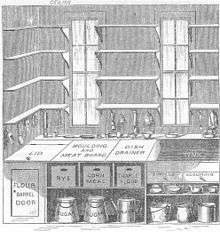
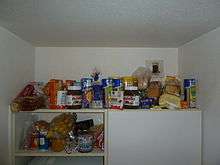
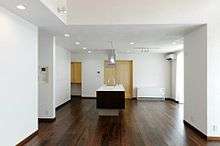
Domestic (or residential) kitchen design is a relatively recent discipline. The first ideas to optimize the work in the kitchen go back to Catharine Beecher's A Treatise on Domestic Economy (1843, revised and republished together with her sister Harriet Beecher Stowe as The American Woman's Home in 1869). Beecher's "model kitchen" propagated for the first time a systematic design based on early ergonomics. The design included regular shelves on the walls, ample work space, and dedicated storage areas for various food items. Beecher even separated the functions of preparing food and cooking it altogether by moving the stove into a compartment adjacent to the kitchen.
Christine Frederick published from 1913 a series of articles on "New Household Management" in which she analyzed the kitchen following Taylorist principles of efficiency, presented detailed time-motion studies, and derived a kitchen design from them. Her ideas were taken up in the 1920s by architects in Germany and Austria, most notably Bruno Taut, Erna Meyer, Margarete Schütte-Lihotzky and Benita Otte, who designed the first fitted kitchen for the Haus am Horn, which was completed in 1923.[8] Similar design principles were employed by Schütte-Lihotzky for her famous Frankfurt kitchen, designed for Ernst May's Römerstadt, a social housing project in Frankfurt, in 1927.
While this "work kitchen" and variants derived from it were a great success for tenement buildings, home owners had different demands and did not want to be constrained by a 6.4-square-metre (69 sq ft) kitchen. Nevertheless, kitchen design was mostly ad-hoc following the whims of the architect. In the U.S., the "Small Homes Council", since 1993 the "Building Research Council", of the School of Architecture of the University of Illinois at Urbana–Champaign was founded in 1944 with the goal to improve the state of the art in home building, originally with an emphasis on standardization for cost reduction. It was there that the notion of the kitchen work triangle was formalized: the three main functions in a kitchen are storage, preparation, and cooking (which Catharine Beecher had already recognized), and the places for these functions should be arranged in the kitchen in such a way that work at one place does not interfere with work at another place, the distance between these places is not unnecessarily large, and no obstacles are in the way. A natural arrangement is a triangle, with the refrigerator, the sink, and the stove at a vertex each.
This observation led to a few common kitchen forms, commonly characterized by the arrangement of the kitchen cabinets and sink, stove, and refrigerator:
- A single-file kitchen (also known as a one-way galley or a straight-line kitchen) has all of these along one wall; the work triangle degenerates to a line. This is not optimal, but often the only solution if space is restricted. This may be common in an attic space that is being converted into a living space, or a studio apartment.
- The double-file kitchen (or two-way galley) has two rows of cabinets at opposite walls, one containing the stove and the sink, the other the refrigerator. This is the classical work kitchen and makes efficient use of space.
- In the L-kitchen, the cabinets occupy two adjacent walls. Again, the work triangle is preserved, and there may even be space for an additional table at a third wall, provided it does not intersect the triangle.
- A U-kitchen has cabinets along three walls, typically with the sink at the base of the "U". This is a typical work kitchen, too, unless the two other cabinet rows are short enough to place a table at the fourth wall.
- A G-kitchen has cabinets along three walls, like the U-kitchen, and also a partial fourth wall, often with a double basin sink at the corner of the G shape. The G-kitchen provides additional work and storage space, and can support two work triangles. A modified version of the G-kitchen is the double-L, which splits the G into two L-shaped components, essentially adding a smaller L-shaped island or peninsula to the L-kitchen.
- The block kitchen (or island) is a more recent development, typically found in open kitchens. Here, the stove or both the stove and the sink are placed where an L or U kitchen would have a table, in a free-standing "island", separated from the other cabinets. In a closed room, this does not make much sense, but in an open kitchen, it makes the stove accessible from all sides such that two persons can cook together, and allows for contact with guests or the rest of the family, since the cook does not face the wall any more. Additionally, the kitchen island's counter-top can function as an overflow-surface for serving buffet style meals or sitting down to eat breakfast and snacks.
In the 1980s, there was a backlash against industrial kitchen planning and cabinets with people installing a mix of work surfaces and free standing furniture, led by kitchen designer Johnny Grey and his concept of the "unfitted kitchen". Modern kitchens often have enough informal space to allow for people to eat in it without having to use the formal dining room. Such areas are called "breakfast areas", "breakfast nooks" or "breakfast bars" if the space is integrated into a kitchen counter. Kitchens with enough space to eat in are sometimes called "eat-in kitchens". During the 2000s, flat pack kitchens were popular for people doing DIY renovating on a budget. The flat pack kitchens industry makes it easy to put together and mix and matching doors, bench tops and cabinets. In flat pack systems, many components can be interchanged.
Other types
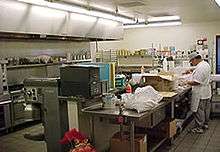
Restaurant and canteen kitchens found in hotels, hospitals, educational and work place facilities, army barracks, and similar institutions are generally (in developed countries) subject to public health laws. They are inspected periodically by public health officials, and forced to close if they do not meet hygienic requirements mandated by law.
Canteen kitchens (and castle kitchens) were often the places where new technology was used first. For instance, Benjamin Thompson's "energy saving stove", an early 19th-century fully closed iron stove using one fire to heat several pots, was designed for large kitchens; another thirty years passed before they were adapted for domestic use.
As of 2017, restaurant kitchens usually have tiled walls and floors and use stainless steel for other surfaces (workbench, but also door and drawer fronts) because these materials are durable and easy to clean. Professional kitchens are often equipped with gas stoves, as these allow cooks to regulate the heat more quickly and more finely than electrical stoves. Some special appliances are typical for professional kitchens, such as large installed deep fryers, steamers, or a bain-marie.
The fast food and convenience food trends have changed the manner in which restaurant kitchens operate. Some of these type restaurants may only "finish" convenience food that is delivered to them, or just reheat completely prepared meals. At the most they may grill a hamburger or a steak. But in the early 21st century, c-stores (convenience stores) are attracting greater market share by performing more food preparation on-site and better customer service than some fast food outlets.[9]
The kitchens in railway dining cars have presented special challenges: space is limited, and, personnel must be able to serve a great number of meals quickly. Especially in the early history of railways, this required flawless organization of processes; in modern times, the microwave oven and prepared meals have made this task much easier. Kitchens aboard ships, aircraft and sometimes railcars are often referred to as galleys. On yachts, galleys are often cramped, with one or two burners fueled by an LP gas bottle. Kitchens on cruise ships or large warships, by contrast, are comparable in every respect with restaurants or canteen kitchens.
On passenger airliners, the kitchen is reduced to a pantry. The crew's role is to heat and serve in-flight meals delivered by a catering company. An extreme form of the kitchen occurs in space, e.g., aboard a Space Shuttle (where it is also called the "galley") or the International Space Station. The astronauts' food is generally completely prepared, dehydrated, and sealed in plastic pouches before the flight. The kitchen is reduced to a rehydration and heating module.
Outdoor areas where food is prepared are generally not considered kitchens, even though an outdoor area set up for regular food preparation, for instance when camping, might be referred to as an "outdoor kitchen". An outdoor kitchen at a campsite might be placed near a well, water pump, or water tap, and it might provide tables for food preparation and cooking (using portable campstoves). Some campsite kitchen areas have a large tank of propane connected to burners, so that campers can cook their meals. Military camps and similar temporary settlements of nomads may have dedicated kitchen tents, which have a vent to enable cooking smoke to escape.
In schools where home economics, food technology (previously known as "domestic science"), or culinary arts are taught, there are typically a series of kitchens with multiple equipment (similar in some respects to laboratories) solely for the purpose of teaching. These consist of multiple workstations, each with its own oven, sink, and kitchen utensils, where the teacher can show students how to prepare food and cook it.
By region
China
Kitchens in China are called chúfáng(厨房). More than 3000 years ago, the ancient Chinese used the ding for cooking food. The ding was developed into the wok and pot used today. Many Chinese people believe that there is a Kitchen God who watches over the kitchen for the family. According to this belief, the god returns to heaven to give a report to the Jade Emperor annually about this family behavior. Every Chinese New Year Eve, families will gather together to pray for the kitchen god to give a good report to heaven and wish him to bring back good news on the fifth day of the New Year.
The most common cooking equipment in Chinese family kitchens and restaurant kitchens are woks, steamer baskets and pots. The fuel or heating resource was also important technique to practice the cooking skills. Traditionally Chinese were using wood or straw as the fuel to cook food. A Chinese chef had to master flaming and heat radiation to reliably prepare traditional recipes. Chinese cooking will use a pot or wok for pan frying, stir frying, deep frying or boiling.
Japan
Kitchens in Japan are called Daidokoro (台所; lit. "kitchen"). Daidokoro is the place where food is prepared in a Japanese house. Until the Meiji era, a kitchen was also called kamado (かまど; lit. stove) and there are many sayings in the Japanese language that involve kamado as it was considered the symbol of a house and the term could even be used to mean "family" or "household" (similar to the English word "hearth"). When separating a family, it was called Kamado wo wakeru, which means "divide the stove". Kamado wo yaburu (lit. "break the stove") means that the family was bankrupt.
India
In India, a kitchen is called a "Rasoi" (in Hindi\Sanskrit) or a "Swayampak ghar" in Marathi, and there exist many other names for it in the various regional languages. Many different methods of cooking exist across the country, and the structure and the materials used in constructing kitchens have varied depending on the region. For example, in north and central India, cooking used to be carried out in clay ovens called "Chulha"s, fired by wood, coal or dried cowdung. In households where members observed vegetarianism, separate kitchens were maintained to cook and store vegetarian and non-vegetarian food. Religious families often treat the kitchen as a sacred space. Indian kitchens are built on an Indian architectural science called vastushastra. The Indian kitchen vastu is of utmost importance while designing a kitchens in India. Modern-day architects also follow the norms of vastushastra while designing Indian kitchens across the world.
While many kitchens belonging to poor families continue to use clay stoves and the older forms of fuel, the urban middle and upper classes usually have gas stoves with cylinders or piped gas attached. Electric cooktops are rarer since they consume a great deal of electricity, but microwave ovens are gaining popularity in urban households and commercial enterprises. Indian kitchens are also supported by biogas and solar energy as fuel. World's largest solar energy[10] kitchen is built in India. In association with government bodies, India is encouraging domestic biogas plants to support the kitchen system.
See also
| Wikimedia Commons has media related to Kitchens. |
References
- "The Pros and Cons of Using A Commercial Sink at Home – Home Decor Expert and". Home Decor Expert. 2018-06-14. Retrieved 2018-07-22.
- Vogel, Carol (1982-12-09). "The commercial litchen at home: pros and cons". New York Times.
- Thompson, Theodor (1992) Medieval Homes, Sampson Lowel House
- Christie, Neil; Creighton, Oliver; Edgeworth, Matt; Hamerow, Helena (2013), Transforming Townscapes: From burgh to borough: the archaeology of Wallingford, AD 800–1400, The Society for Medieval Archaeology Monograph Series, Oxford: Society for Medieval Archaeology, p. 201, ISBN 978-1-909662-09-4
- Creighton, Oliver; Christie, Neil (2015), "The Archaeology of Wallingford Castle: a summary of the current state of knowledge", in Keats-Rohan, K. S. B.; Christie, Neil; Roffe, David (eds.), Wallingford: The Castle and the Town in Context, BAR British Series, Oxford: Archaeopress, p. 13, ISBN 978-1-4073-1418-1
- Trumbull, J. Hammond (1850). The Public Records of the Colony of Connecticut 1636–1776. Vol. 1. p. 476.
- Rawsthorn, Alice (2010-09-27) Modernist triumph in the kitchen. New York Times
- Moore, Rowan (2019-01-21). "Bauhaus at 100: its legacy in five key designs". The Guardian. Retrieved 2019-01-21.
- Blank, Christine (9 January 2014). "C-Stores Eating Your Lunch". QSR Magazine.
- "World's Largest 38500-meal Solar Kitchen in India". Retrieved 2017-03-17.
Further reading
- Beecher, C. E. and Beecher Stowe, H.: The American Woman's Home, 1869. The American Woman's Home
- Cahill, Nicolas. Household and City Organization at Olynthus ISBN 0-300-08495-1
- Cromley, Elizabeth Collins. The Food Axis: Cooking, Eating, and the Architecture of American Houses (University of Virginia Press; 2011); 288 pages; Explores the history of American houses through a focus on spaces for food preparation, cooking, consumption, and disposal.
- Harrison, M.: The Kitchen in History, Osprey; 1972; ISBN 0-85045-068-3
- Kinchin, Juliet and Aidan O'Connor, Counter Space: Design and the Modern Kitchen (MoMA: New York, 2011)
- Lupton, E. and Miller, J. A.: The Bathroom, the Kitchen, and the Aesthetics of Waste, Princeton Architectural Press; 1996; ISBN 1-56898-096-5. The Bathroom, the Kitchen and the Aesthetics of Waste
- Snodgrass, M. E.: Encyclopedia of Kitchen History; Fitzroy Dearborn Publishers; (November 2004); ISBN 1-57958-380-6
External links
![]()